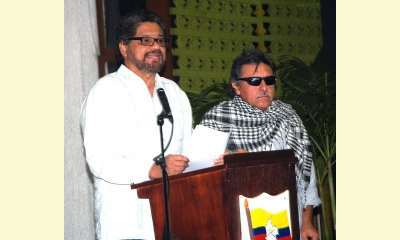|
|
FARC-EP y Gobierno colombiano avanzan en acuerdos para la paz
un article par Prensa Latina
La insurgencia colombiana y el Gobierno de ese país
anunciaron hoy aquí (11 abril, La Habana) avances en
la construcción de acuerdos para la solución del
problema de las drogas ilícitas.

click on photo to enlarge
En declaración conjunta emitida esta mañana
durante el cierre del XXIII ciclo de negociaciones
de paz, las Fuerzas Armadas Revolucionarias de
Colombia-Ejército del Pueblo (FARC-EP) y su
contraparte dijeron que comparten visiones sobre
la erradicación definitiva de ese fenómeno.
Afirmaron que la solución debe estar enmarcada en la
Reforma Rural Integral y elaborarse de manera
conjunta, con la participación de las comunidades en
el diseño, ejecución, seguimiento, control y
evaluación de las acciones.
Las partes reiteraron la invitación al pueblo
colombiano a participar con sus propuestas en las
discusiones de la mesa de diálogos, instalada en La
Habana desde noviembre de 2012.
Además, agradecieron Cuba y Noruega, países garantes
de las negociaciones; y a Chile y Venezuela,
acompañantes del proceso, por el apoyo constante en
el transcurso de las pláticas.
Informaron que retomarán el trabajo en la mesa el 24
de abril.
La cuestión de las drogas ilícitas es el tercer tema
en tratarse de una agenda de seis puntos.
Las FARC-EP y el Gobierno han arribado a acuerdos
parciales relacionados con el desarrollo agrario y
la participación política.
( Clickear aquí para la version inglês)
|








|
DISCUSSION
Question(s) liée(s) à cet article:
What is happening in Colombia, Is peace possible?
* * * * *
Commentaire le plus récent:
The force of non-violence constrains the force of arms!
Colombia - the force of peaceful resistance -
At the beginning of July, the rebels of the armed revolutionary forces of Colombia (FARC) kidnapped a 51 year old Swiss, and his Colombian assistant who worked in the Indian communities of Cauca province where they were setting up development projects by building schools and community production enterprises.
The news of the kidnapping was spread through all the villages and 2000 Indians set out to pursue the 400 guerillas. They reached them at an elevation of over 4000 meters (12,000 feet), encircled them, and without any weapon, constrained them to release the 2 hostages! (After 2 days, the hostages were released).
This release, obtained through "peaceful resistance" has raised a national debate: the possibility of resisting violence without needing to use weapons has demonstrated the effectiveness of human solidarity movements.
"I will return, and I will then be millions" prophesied the Aymara Indian leader Tapak Katari, in 1781, at the time of his execution by the Spanish conquistadors.
100 million in 1492, the Indians were no more than 4,5 million one century and half later. Currently there are 44 million Indians populating Latin America.
In spite of their great diversity, the Indian movements take on more and more importance. In Ecuador, Guatemala, Bolivia, Peru, Mexico or Colombie they are opposed to the neoliberal system that governs the Americas, while protesting against the imposition of the American economic market. . ... continuation.

|
|









